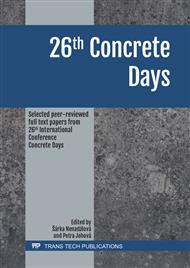p.186
p.193
p.201
p.208
p.216
p.222
p.228
p.234
p.240
The Analysis of Shear Forces Flow around the Supports of Flat Slabs
Abstract:
This paper deals with both linear and non-linear analysis of shear forces distribution in the area near the supports of the flat slabs. With a cross-section ratio of cmax / cmin > 3, the main amount of the shear stress is concentrated near the column or wall corners bases. As a consequence of this phenomenon, it is necessary to reduce the control perimeter when evaluating the punching shear resistance of a flat slab. The fragments of the flat slabs with the thickness of 200 mm supported by a wall with various loading conditions were analyzed. The results according to the Eurocode 2 were compared to a non-linear shear resistance evaluation that was calibrated based on the results from the previous experiments. Based on thus evaluated punching shear resistances, the theoretical reduced control perimeter was determined and subsequently it was compared to design model Eurocode 2. The physical basis for determining reduced control perimeters is based on the shear force concentration near the support.
Info:
Periodical:
Pages:
216-221
Citation:
Online since:
August 2020
Authors:
Price:
Сopyright:
© 2020 Trans Tech Publications Ltd. All Rights Reserved
Share:
Citation:


